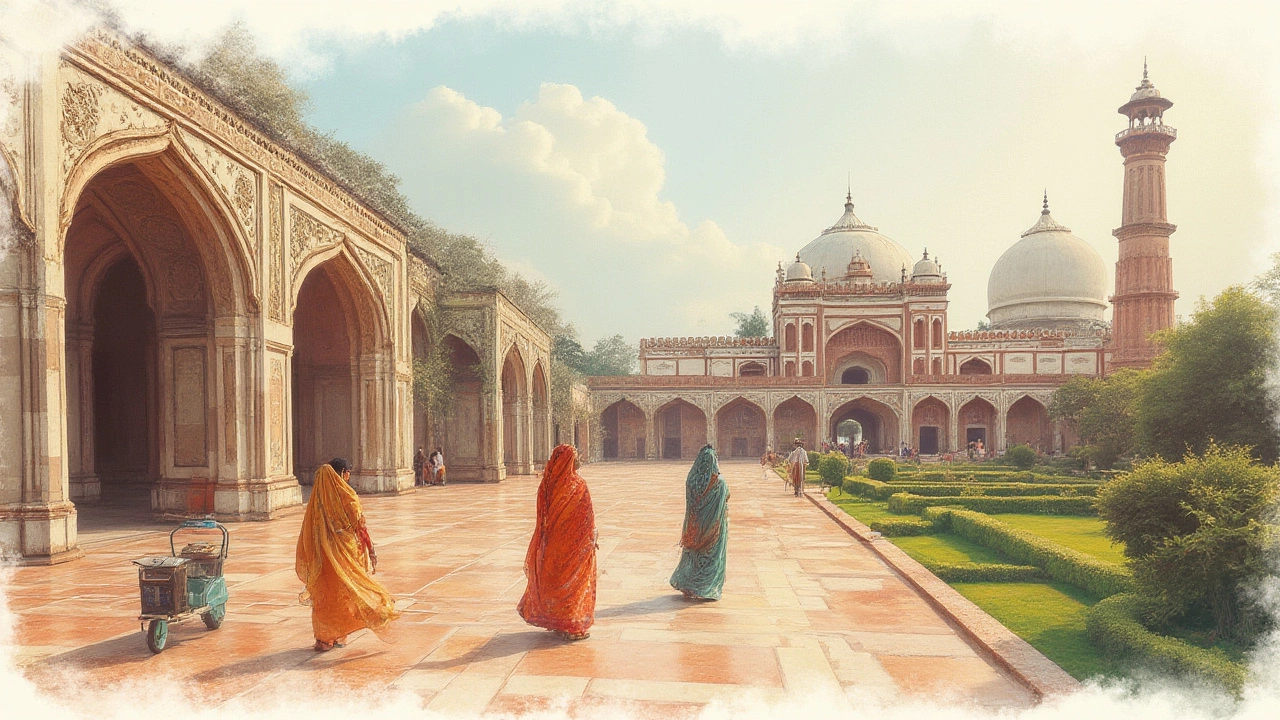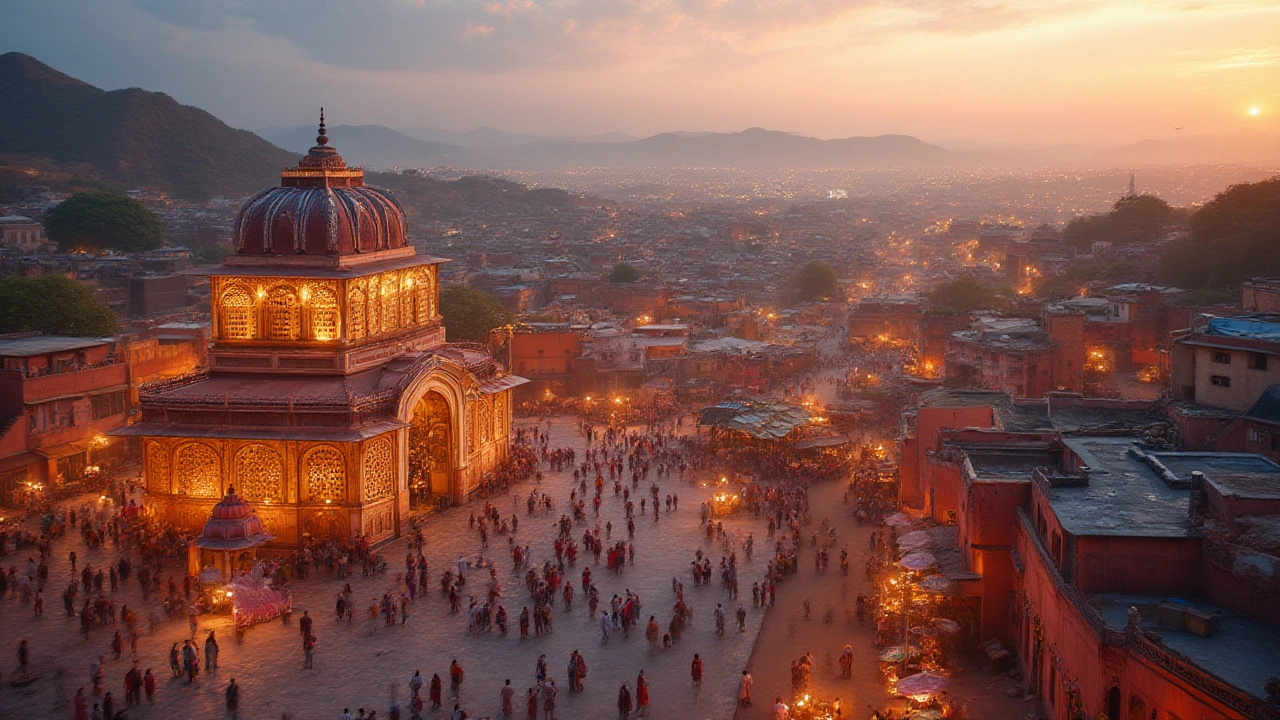People have fierce debates about the most beautiful architecture in India. It gets heated because the country’s cities are a kaleidoscope of design: ancient temples, glittering palaces, bold colonial relics, swirling Islamic domes, and futuristic innovation. What makes it even trickier is India’s diversity—one state’s jaw-dropping stone carvings are another’s riot of marble, color, and arches. Anyone who’s wandered busy Indian streets knows it’s impossible to look away for long without missing something spectacular. And yet, among all these marvels, which city truly claims the crown?
The Historic Powerhouse: Jaipur’s Regal Palette
Ask anyone about iconic Indian architecture, and Jaipur jumps to the front of the line almost immediately. Rajasthan’s pink capital feels like a fairy tale but constructed in stone. The old town, painted salmon-pink since 1876 to welcome Prince Albert, is an Instagram favorite. But the color isn’t the best part; the city is all about intricate patterns and imagination. Hawa Mahal, for example, looks almost like a honeycomb, with its 953 windows letting royal ladies peep at the outside world unseen. Take a stroll by its facade, and there’s a sense of mathematical poetry mixed with wild creativity—plus a clever natural air conditioning trick built in centuries ago to beat the desert heat.
The City Palace, still home to the former royal family, overflows with courtyards, gardens, and chandeliers, each space more lavish than the last. It’s where Mughal, Rajput, and European styles meet in a swirl of marble and frescoes. Just nearby, Jantar Mantar presents another twist: massive stone instruments from the 1700s, still able to track astrological movements with mind-bending accuracy. And outside town, Amber Fort’s mirrored walls look like a disco ball when the sun hits just right. Make time for Nahargarh Fort too—the view over Jaipur at sunset, with the city lights flickering beneath ancient ramparts, is pure magic.
Jaipur’s beauty isn’t only in its palaces and forts. Wandering the old city, you spot details everywhere—jalis (latticed windows), carved doorways, markets bursting with arches and domes, courtyards framed by tall wooden doors. There are guides who’ll point out secret balconies, old merchant havelis, and hidden shrines that don’t show up in guidebooks. For architecture buffs, every street corner opens a new chapter of design history—one where Hindu, Mughal, and colonial legacies overlap with raw Rajasthan energy. If you want tips for exploring: visit early morning before crowds hit, and don’t just tick off sights; slow down in alleyways. Local architects even arrange special tours of lesser-known gems, where you can chat with restorers saving old tiles from decay.
Agra: The Timeless Marvel of Mughal Grandeur
You can’t talk about glorious architecture in India and not mention Agra. The city’s name is practically glued to the architecture in India keyword—thanks to the world’s most famous tomb, the Taj Mahal. But there’s much more once you start looking. The Taj, with its pure white marble, perfect symmetry, and inlaid gems, is gorgeous from every angle and deserves its wonder-of-the-world status. Those minarets aren’t just pretty; they tilt outwards, designed to fall away from the tomb in an earthquake. Early morning or moonlit viewings take the experience from extraordinary to almost surreal.
Move beyond the Taj, and Agra keeps delivering. The mighty Agra Fort is a UNESCO site, with massive red sandstone walls enclosing a palace-within-a-palace. Diwan-i-Khas shines with marble inlays, while underground tunnels hint at stories untold. Fatehpur Sikri, built by Emperor Akbar a short drive away, is an architectural experiment of epic proportions—a city planned and abandoned, but still just as breathtaking. Its Buland Darwaza, the highest gateway in the world, shouts about the ambitions of its Mughal builders. The interconnected pavilions, dainty courtyards, and airy halls reveal an obsession with light and ventilation. Inside the Jama Masjid mosque, architecture and spiritual calm blend effortlessly.
Tips for history lovers: Don’t stick to the big ticket sites. Check out Itimad-ud-Daulah, the “Baby Taj,” where delicate pietra dura technique was practiced before being perfected on the main event. Wander the Mehtab Bagh gardens at sunset for a different view of the Taj—minus the crowds, but with the same magic. For facts fans, the Mughals introduced techniques still copied by modern architects: arches that distribute weight to keep massive domes standing centuries later, or marble cladding that stays cool in the scorching Uttar Pradesh summer. Grab a local tuk-tuk and ask your driver about his own favorite hidden building—you’ll hear stories passed down families working on the Taj for generations.

Chennai and South India: Dravidian Dreamscape
Head south, and architecture looks and feels entirely different. Chennai, the gateway to Tamil Nadu, is where you find living temples rising out of city buzz, ancient gopurams (gateway towers), and British-era Indo-Saracenic buildings. The Kapaleeshwarar Temple in Mylapore smacks you in the face with thousands of riotous, painted carved figures sprawling up each gopuram, each layer telling a piece of a Hindu legend. Unlike the palaces of the north, South Indian temples are designed as energetic spiritual hubs. People actually live and work inside the complex—shops, schools, even markets tangled through sacred corridors. St. Thomas Cathedral adds Catholic touches, and the Madras High Court, with its red domes, remains one of the world’s largest judicial complexes built with a dizzying East-meets-West style.
The real architectural adventure, though, happens when you travel beyond Chennai into Tamil Nadu. UNESCO sites like the Shore Temple at Mahabalipuram and the carved cave temples of the Pallava dynasty blow minds. The temples at Thanjavur and Madurai are living encyclopedias of sculpture, topped with 200-foot towers crawling with statues. Fact check: the Brihadeeswara Temple dome weighs almost 80 tons, perched using a ramp over a kilometer long—built 1000 years ago, before heavy machines. Guides will tell you dozens of outrageous legends about how these miracles got constructed.
Tips for visitors: Dress and behave respectfully in sacred areas. Early morning and dusk are best, not just for the photos but for hearing ancient chants and seeing flickering oil lamps reflected in pools. Local markets around temples sometimes sell hand-carved stone miniatures—unique souvenirs with real cultural stories. And if you want to deep dive, check out heritage walks run by architects and historians, or explore Chettinad mansions with their sunlit courtyards and Belgian glass. You won’t find these on most travel lists, but they’re unforgettable once you see them in person.
Modern Marvels: Chandigarh’s Vision and Mumbai’s Skyline
Not every Indian city looks backward for inspiration. Chandigarh, designed by Le Corbusier, is still a mind-blowing experiment in modern architecture and planning. Built after Partition as a symbol of a new India, its rectangles, open spaces, and tree-lined avenues feel unlike anywhere else. Head to the Capitol Complex, now a World Heritage Site, and you’ll understand—brutalist concrete, bold sculpture, and functional beauty built for a democratic dream. The Rock Garden, filled with sculptures made from junk and recycled bits, is both quirky and beautiful—a perfect example of how Indian cities remix design with whatever’s at hand.
Mumbai, by contrast, fizzes with contrasts. You’ll spot Art Deco movie theaters lining Marine Drive, second only to Miami in density, sitting right next to Gothic Revival wonders like the Chhatrapati Shivaji Maharaj Terminus. Mumbai’s colonial core is a checkerboard of arches, twisted ironwork, stained glass, and Indo-Saracenic grandeur, all set against glassy skyscrapers that grow taller every year. For stats lovers: Mumbai's skyline now includes more than 50 skyscrapers over 150 meters tall, a number rising steadily each year.
If you explore Mumbai by foot, try following a self-led Art Deco trail around south Mumbai, or duck into hidden synagogues and Parsi fire temples that tell the story of migration and industry boomtowns. Meanwhile, Bandra's graffiti alleys and design cafés show how new architecture works side-by-side with ancient churches and fishing villages. For those looking for different kinds of beauty, book a spot on heritage walks that ramble through everything from Victorian ballrooms to futuristic museums. It’s the mix—old bones, new ideas—that defines Mumbai.
| City | Signature Style | Must-See Landmarks | Fun Fact |
|---|---|---|---|
| Jaipur | Rajput, Mughal fusion | Hawa Mahal, Amber Fort | Old city painted pink to honor Prince Albert in 1876. |
| Agra | Mughal | Taj Mahal, Agra Fort | Taj Mahal took 22 years and 20,000 workers to build. |
| Chennai | Dravidian, Colonial | Kapaleeshwarar Temple, Madras HC | Brihadeeswara Temple's dome weighs 80 tons! |
| Chandigarh | Modernist | Capitol Complex, Rock Garden | Only Indian city designed by a single foreign architect. |
| Mumbai | Colonial, Art Deco, Modern | Marine Drive, CST Terminus | Second largest Art Deco collection worldwide. |
So, which city wins? It really depends on what kind of beauty you crave: pink palaces, marble mausoleums, temple towers, or glassy skyscrapers set on a tropical coastline. India’s cities are like a living museum, each more dazzling—and more surprising—the deeper you dive. Wherever you go, the tip is the same: look up, look down, and look all around, because India’s architectural magic is everywhere.
